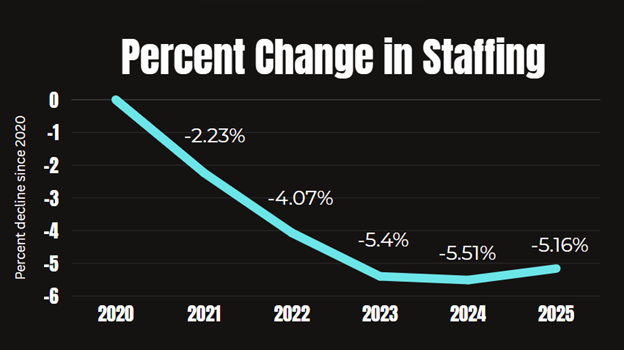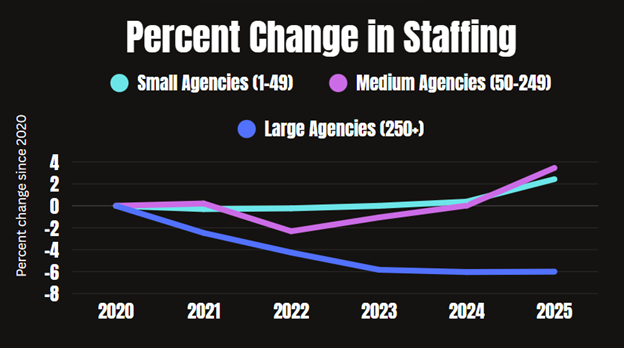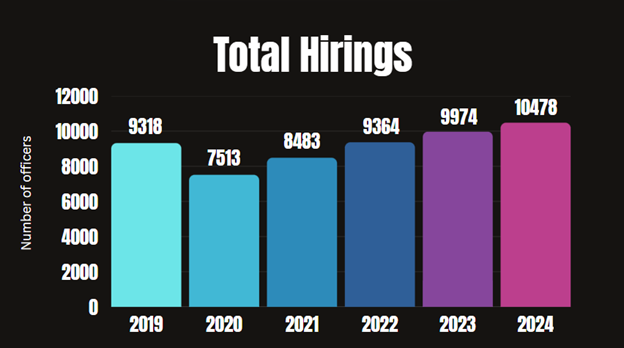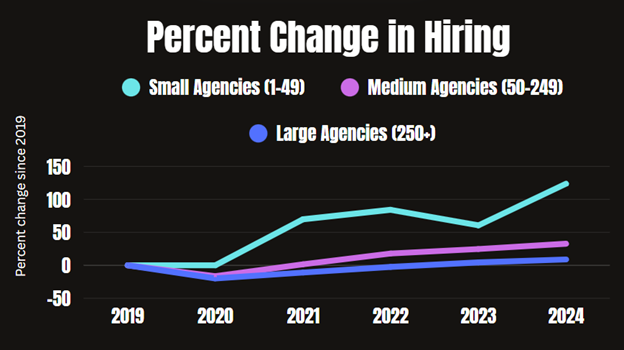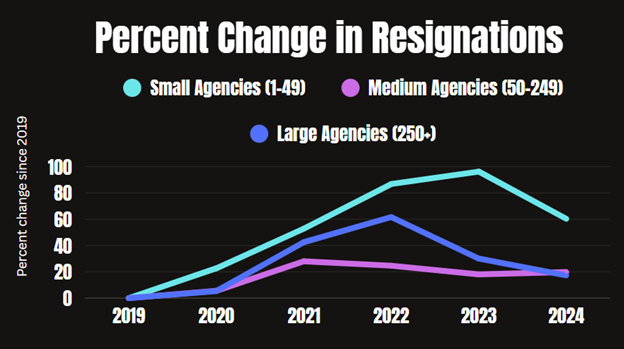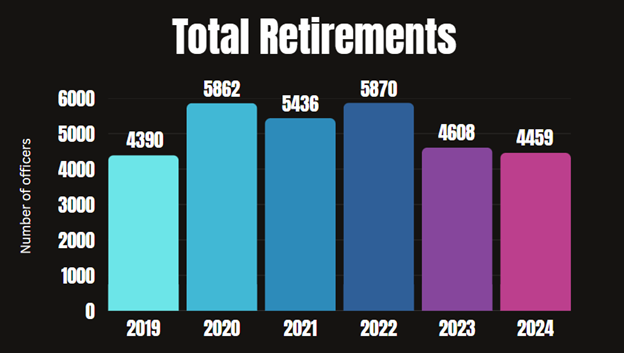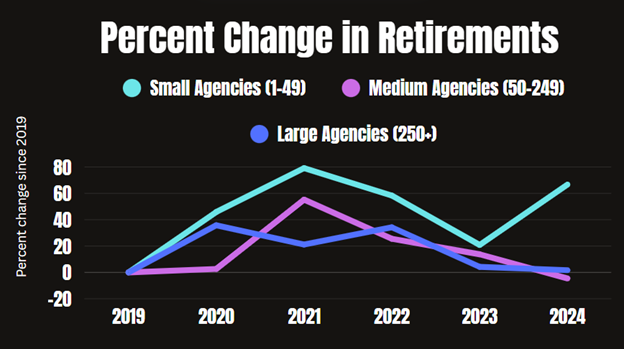|
July 5, 2025 PERF survey shows police staffing increased slightly in 2024 but still lower than 2019
PERF members, Last year, PERF shared information with you about our members’ staffing trends from 2019 through 2023. The survey results below include updated information through 2024. Respondents reported their overall sworn staffing numbers were 0.4 percent higher on January 1, 2025, than on January 1, 2024, but were still 5.2 percent lower than they were on January 1, 2020. The total number of sworn hirings among respondents has increased every year since 2020 and is now above the 2019 level. Resignations among those surveyed decreased in 2023 and 2024, but remain higher than in 2019 and 2020. And respondents’ retirements were significantly elevated from 2020 through 2022, but are now nearing their 2019 level. 
It’s clear that staffing is still a major issue for many agencies across the country. Previous PERF projects on recruitment, hiring, and retention have found that today’s officers are looking for stability, both in their community and within their agency. Quality of life is a priority for them, and money alone is not as motivating for them as it was for previous generations. Our projects found officers were already prioritizing work-life balance before the events of 2020. Below are a few examples of steps—including offering financial incentives, adjusting hiring standards, streamlining hiring processes, and improving non-financial offerings—agencies have recently taken to address their staffing challenges.
Survey Results PERF sent this survey to the 795 members who are chief executives of their agencies (chiefs, sheriffs, commissioners, etc.). We received responses from 39 states, the District of Columbia, and three Canadian provinces. Respondents included 198 local law enforcement agencies; nine college, university, or school district law enforcement agencies; three state agencies; three transportation agencies; two agencies responsible for parks or waterways; one federal agency; and one hospital agency. These agencies collectively employed more than 128,000 officers on January 1 of this year. Large agencies are overrepresented among PERF’s membership and therefore were overrepresented in this survey. Staffing The survey asked for agencies’ total sworn staffing on January 1 of every year from 2020 to 2025. Total staffing dropped 5.5 percent from January 1, 2020, to January 1, 2024, then rose 0.4 percent during 2024.
These results generally reflect trends reported by respondents from large agencies (250 or more sworn officers), which saw staffing rise slightly in 2024, but still employed 6 percent fewer officers on January 1, 2025, than on January 1, 2020. Those from medium-sized agencies (50-249 sworn officers) reported their staffing levels rose 3.6 percent during 2024. They employed 3.5 percent more officers on January 1, 2025, than on January 1, 2020. Respondents from small agencies (1-49 sworn officers) reported their staffing levels rose 2 percent during 2024. They employed 2.4 percent more officers on January 1, 2025, than on January 1, 2020.
Hirings Hiring has rebounded to well above pre-2020 levels. In 2024, respondents hired 5 percent more officers than in 2023 and 12.5 percent more than in 2019.
Agencies of all sizes reported strong hiring numbers. Responding large agencies hired 4.4 percent more officers last year than in 2023, and 8.9 percent more than in 2019. Those among medium-sized agencies hired 6.4 percent more officers last year than in 2023 and 32.7 percent more than in 2019. Responding small agencies hired 39 percent more officers last year than in 2023 and 123.7 percent more than in 2019.
Resignations Survey results show that resignations rose from 2020 through 2022, then declined in 2023 and 2024 but remained elevated above pre-2020 levels. In 2024, respondents reported 8.3 percent fewer resignations than in 2023, but 18.4 percent more resignations than in 2019.
Though large and small agencies reported that resignations decreased from 2023 to 2024, respondents from agencies of all sizes had more resignations last year than in 2019. Responding large agencies reported 9.8 percent fewer resignations last year than in 2023, but 17.4 percent more than in 2019. Responding medium-sized agencies reported 1.5 percent more resignations last year than in 2023 and 19.8 percent more than in 2019. Small agencies surveyed reported 18.3 percent fewer resignations last year than in 2023 but 60.4 percent more than in 2019.
Retirements After several years of increased retirements, the number of retirements reported by respondents nearly returned to 2019 levels. Survey results show 3.2 percent fewer retirements last year than in 2023 and 1.6 percent more than in 2019.
Responding large and medium-sized agencies were faring better with retirements than small agencies. Compared to 2019, large agencies reported 1.7 percent more retirements last year, and medium agencies reported 4.6 percent fewer retirements, while small agencies reported 66.7 percent more retirements.
Staffing continues to be a top concern for many police chiefs and sheriffs. Many departments have resources to hire, but the demand for officers exceeds the supply of those interested in taking the job. If agencies continue to be understaffed, they may need to find alternative ways to meet their communities’ needs. Have a wonderful holiday weekend! Best, Chuck |

